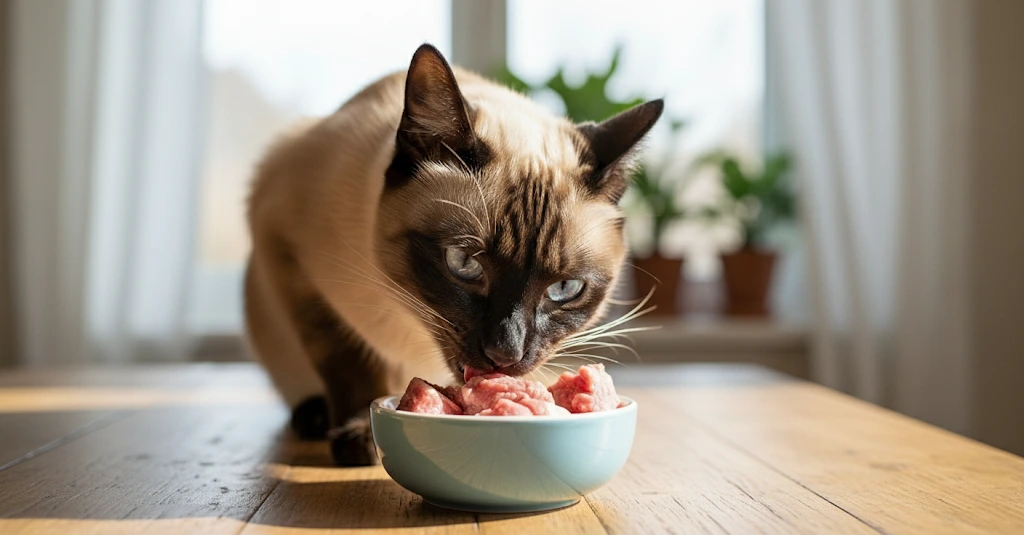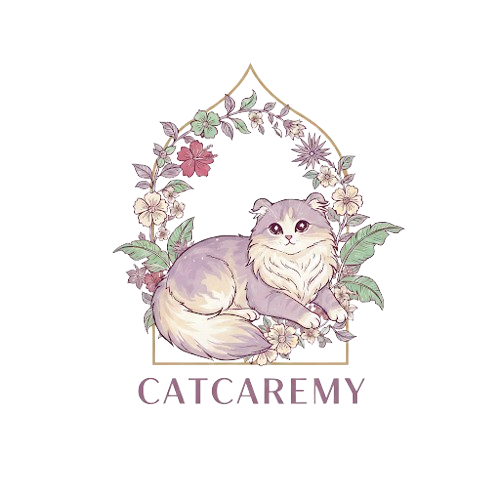
Feeding a raw diet for cats has gained traction among pet parents who want to offer meals closer to what felines would eat in the wild. Supporters believe it enhances digestion, coat shine, and vitality, while critics highlight concerns about bacteria, affordability, and long-term balance. So, is raw cat food safe for cats, and how does it compare in cost to premium kibble?
What Exactly Is a Raw Cat Food Diet?
A raw diet for cats — often referred to as BARF (Biologically Appropriate Raw Food) — typically contains:
- Fresh raw meat such as chicken, fish, beef, or lamb.
- Organ meats like liver, heart, or kidney.
- Raw bones for calcium.
- Additional supplements for taurine and vitamins.
Unlike homemade versions, which can be risky if poorly formulated, commercial raw diets available in this region are frozen or dehydrated to preserve nutrients. Examples include:
- Coco & Joe BARF – a well-known local pioneer in frozen raw patties.
- PledgeCare – dehydrated, air-dried meals inspired by raw nutrition.
- Feline Natural – premium freeze-dried meals from New Zealand.
- Orijen Freeze-Dried & Orijen Cat & Kitten Kibble – imported premium alternatives often compared with raw.
These can be found in local pet shops, online platforms like Shopee or Lazada, and selected veterinary clinics.
Is Raw Cat Food Safe for Cats?
This is the biggest debate: “Is raw cat food safe?”
- Supporters argue raw diets mimic natural feline nutrition, improving stool quality, fur texture, and energy.
- Risks include bacterial contamination such as Salmonella and E. coli if storage or handling is poor. The American Veterinary Medical Association (AVMA) policy on raw feeding notes contamination risks are a serious concern.
- Regional veterinary perspective: Many vets don’t reject raw diets outright but emphasize using trusted commercial brands over homemade recipes. Hygiene, balanced nutrition, and safe storage are the top concerns raised in local clinics.
👉 Conclusion: Raw diets can be safe if sourced from reputable brands and prepared hygienically.
Pros and Cons of Feeding Raw Diets
Benefits of Raw Cat Food
- Promotes shiny coats and healthier skin.
- May reduce stool odor and volume.
- Suitable for some cats with food sensitivities.
- Aligns closely with natural feline eating patterns.
Risks of Raw Cat Food
- Greater chance of bacterial contamination.
- Homemade versions often lack critical nutrients.
- More expensive than economy dry food.
- Less convenient for owners with busy schedules.
If you’re interested in a DIY approach but worried about risks, check our guide on [safe homemade cat food recipes vet-approved).
Cost of Raw Cat Food vs Kibble
One of the most practical concerns for local pet owners is affordability. While some assume raw diets are always much more expensive, the numbers show a more nuanced picture.
Price-Per-Serving Comparison
| Brand / Type | Pack Size & Price (MY) | Daily Serving | Est. Cost per Day | Est. Cost per Month |
|---|---|---|---|---|
| Coco & Joe BARF (local raw) | 1 kg @ RM 28–32 | 120 g | RM 3.50–4.00 | RM 105–120 |
| PledgeCare Dehydrated Raw | 500 g (rehydrates ~2 kg) @ RM 65 | 100 g | RM 3.25–3.50 | RM 100–110 |
| Feline Natural (freeze-dried) | 320 g @ RM 130 | 40 g | RM 16.00+ | RM 450–480 |
| Orijen Cat & Kitten (premium kibble) | 1.8 kg @ RM 152 | 60 g | RM 5.00–5.20 | RM 150–160 |
| Whiskas Dry Food (economy kibble) | 1.2 kg @ RM 25 | 60 g | RM 1.20 | RM 36–40 |
👉 Local brands like Coco & Joe or PledgeCare can actually be cheaper than imported kibble such as Orijen, while still delivering a high-protein diet.
Interactive Cost Calculator
Use this simple tool to estimate cost per cat per month. It includes presets for popular brands in the region.
🐾 Raw Diet Cost Calculator
Should You Try a Raw Diet?
If you’re curious about raw feeding, here are some steps:
- Begin with small portions from trusted local brands.
- Track your cat’s stool quality, coat, and energy.
- Practice strict hygiene: wash hands, bowls, and storage containers.
- Speak with your vet, especially if your cat has chronic conditions.
For pet parents who want the nutritional density of raw but without the storage hassle, high-protein kibbles like Orijen or Acana may be a practical middle ground.
For more alternatives, explore our [adult cat food guide ).
Is Your Cat a Raw Food Refuser? A Guide to Winning Over Picky Eaters
Transitioning your cat to a raw food diet can be one of the best decisions you make for their health, but it’s often a frustrating journey. Many cats, especially those accustomed to a lifetime of kibble, will turn up their nose at this new, unfamiliar food. The good news is that with the right strategy and a healthy dose of patience, you can successfully convert even the most stubborn feline.
The Gradual Transition Method: Slow and Steady Wins the Race
This is the most effective and least stressful approach for both you and your cat. The goal is to slowly introduce the new food without shocking your cat’s digestive system or their sensibilities.
Step 1: The “Sprinkle” Introduction Start by taking a very small amount of raw food—no more than a pea-sized portion—and mixing it into your cat’s regular wet or dry food. The key is to make the raw food almost undetectable. Many cats will eat it without noticing the change.
Step 2: Increase the Ratio Over the next week or two, gradually increase the amount of raw food while simultaneously decreasing the amount of their old food. Do this in very small increments. For example, add a little more raw food every two to three days. Pay close attention to your cat’s response. If they show any signs of refusal, go back to the previous ratio for a few more days before trying to increase again.
Step 3: The Separate Bowl Once your cat is comfortably eating a significant mix of raw and old food, try serving the raw food in a separate bowl next to their old food. This allows them to choose and get more comfortable with the raw food on its own terms.
Step 4: Full Transition When your cat is regularly eating the raw food, you can begin to phase out the old diet entirely. This process can take anywhere from a few weeks to several months, so don’t rush it.
The Flavor Enticement Method: Making Raw Food Irresistible
Sometimes, a cat just needs a little extra encouragement. You can make the raw food more appealing by adding familiar and enticing flavors.
- Meat Broth: Add a small amount of warm, low-sodium chicken, beef, or bone broth to the raw food. This not only adds a delicious aroma but also mimics the moisture content of wet food, which many cats prefer.
- Nutritional Yeast or Catnip: A small sprinkle of nutritional yeast can add a savory, cheese-like flavor that many cats find irresistible. Similarly, a pinch of catnip can pique their curiosity and make the new food a more positive experience.
- Crumbled Treats: If your cat has a favorite treat, try crumbling a small amount over the top of the raw food. This can mask the unfamiliar scent and taste, encouraging them to take that first brave bite.
- Warm it Up: Gently warming the raw food (do not cook it!) can release its natural aromas, making it more appetizing. Place the food in a sealed plastic bag and run it under warm water for a few minutes.
Patience and Perseverance: The Mindset You Need to Succeed
This journey is a marathon, not a sprint. Your cat may have been eating the same processed diet for years, and a fundamental change in their food will require time and patience.
- Be Patient: Do not force your cat to eat the raw food. If they refuse to eat the mixture, simply go back to the previous step or ratio and try again later. Forcing them can create a negative association with the new food.
- Consistency is Key: Stick to a consistent feeding schedule. Cats are creatures of habit, and predictability can reduce stress during the transition.
- Avoid “Free Feeding”: While transitioning, it’s best to move away from leaving food out all day. Offer food at specific times and remove it after 20-30 minutes if it’s not eaten. This can help create a healthy appetite.
- Consult a Veterinarian: Always consult with a veterinarian, especially one knowledgeable about feline nutrition and raw diets, before making a significant change to your cat’s diet.
Key Takeaways
- A raw diet for cats can cost anywhere between RM 100–RM 400 per month, depending on brand and protein source.
- Local options like Coco & Joe BARF and PledgeCare offer balanced nutrition at reasonable prices.
- Premium freeze-dried imports such as Feline Natural are convenient but costly.
- Hygiene, portion control, and vet guidance are non-negotiable for safe raw feeding.
- If raw feels overwhelming, premium kibble still provides a safe and nutritious option.
Everything You Need to Know About Feeding Your Cat a Raw Diet
Can cats eat raw chicken safely?
Yes, cats can eat raw chicken, but only if it is handled properly. Raw chicken should be sourced from a trusted supplier, frozen until use, and thawed under safe conditions. The main risk is bacterial contamination (Salmonella, E. coli). If you choose raw chicken, ensure it is part of a balanced diet — plain chicken alone does not provide taurine or essential vitamins. Most vets recommend using commercially prepared raw diets rather than feeding plain raw chicken.
How much raw food should I feed my cat per day?
On average, adult cats require about 2–3% of their body weight in raw food daily.
A 4 kg cat would need roughly 80–120 g of raw food per day.
Active or younger cats may require slightly more, while senior cats may need less.
Commercial raw brands like Coco & Joe or PledgeCare often provide feeding guidelines on the packaging, which makes it easier for owners to calculate portions.
Is raw cat food safe for kittens?
Kittens can benefit from raw diets because of their higher protein needs, but balance is critical. Unbalanced raw diets may lead to stunted growth or nutritional deficiencies. If feeding kittens raw, always choose formulated products designed for all life stages and consult a vet before starting.
Is raw cat food more expensive than kibble?
Not always. While premium freeze-dried raw can be pricey, local frozen raw options (like Coco & Joe BARF) are sometimes cheaper than imported kibbles such as Orijen.
Local raw: RM 3.50–4.00 per day (per cat).
Premium kibble: RM 5.00+ per day.
Economy kibble: RM 1.20 per day.
👉 Use our calculator above to work out your own monthly cost.
How do I transition my cat from kibble to raw food?
Transitioning should be gradual:
1.Start by mixing 10–20% raw food with your cat’s usual kibble.
2.Slowly increase the raw portion over 2–3 weeks.
3.Monitor for changes in stool, appetite, or energy.
4.Never switch abruptly — this may cause digestive upset.

[…] Is Raw Cat Food Safe for Cats? […]